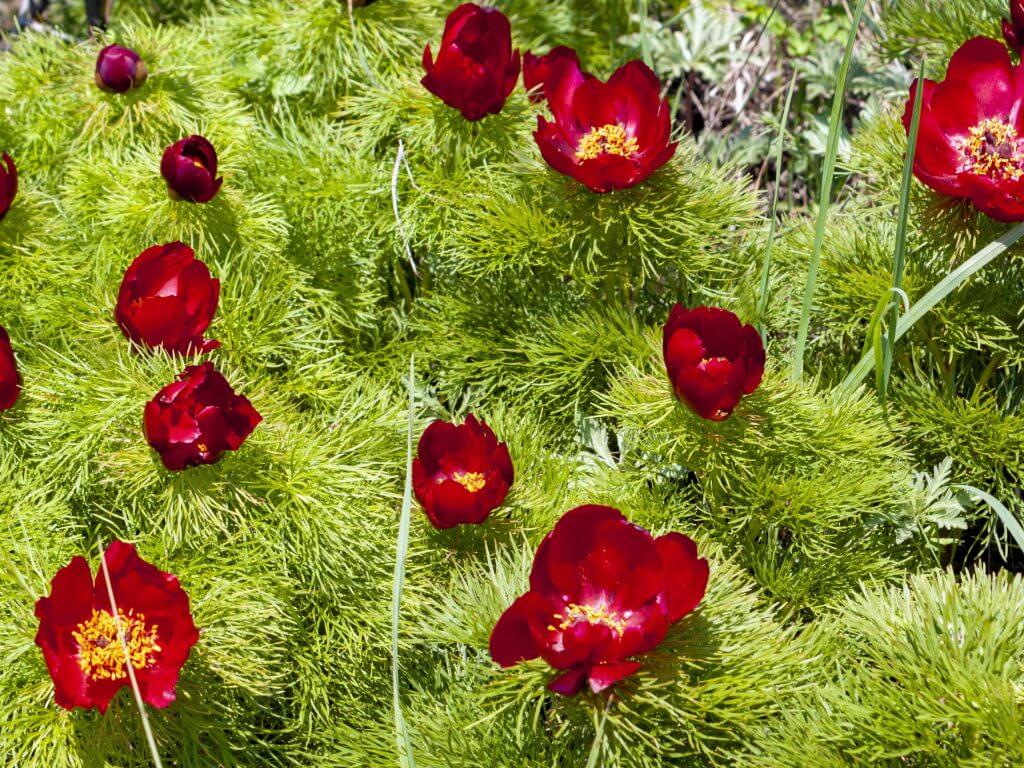
Garden Peonies
Garden peonies (Paeonia lactiflora) are a marvel. Starting each spring as eager reddish shoots, they emerge from the warming soil and grow quickly to at least three feet tall and wide. By late spring, mature plants are covered with fat buds that open to large, luxurious flowers. Bloom configurations run the gamut from simple, poppy-like shapes to fluffy globes with scores of petals. A century ago, the garden peony color range was limited to white, pink and red. Now, thanks to extensive breeding efforts, gardeners can enjoy those shades plus an array of yellow and apricot tones. Bicolored varieties are also widely available.
Tree Peonies

But garden peonies are only the beginning of the peony story. Tree peonies (Paeonia suffruticosa), long loved in Japan and their native China, have gained popularity among peony fanciers elsewhere. Ranging from 2 ½ to 5 feet tall and 5 to 6 feet wide, the woody shrubs feature dissected foliage and large flowers, similar to those of garden peonies but bigger. Though they lose their leaves in fall, tree peonies do not die back to the ground like their herbaceous relatives. In mid to late spring, extravagant, ruffled flowers open in a wide range of colors. Tree peony blossoms frequently feature combinations of one or more hues, often shading darker towards the centers, the better to showcase large clusters of golden stamens.
Intersectional or Itoh Peonies
Intersectional or Itoh peonies were created by crossing garden and tree peonies. Originally hybridized by a Japanese plantsman, Toichi Itoh, the intersectionals have been commercially available since the late 1960s. Like herbaceous peonies, they sprout annually from “eyes” or below-ground buds and combine the best traits of tree and herbaceous species. The flowers are held above the foliage on plants that remain attractive long after the flowers have faded. The blooms are especially large and some of the most eye-catching varieties, including the best-selling ‘Bartzella,’ feature distinctive deep yellow coloring that is a hallmark of intersectional varieties.
Species Peonies

Though garden and tree peonies are the best known, the genus Paeonia is home to over 35 species. Some, like the red-flowered Delavay’s tree peony (Paeonia delavayi), are garden favorites that have also been used extensively for hybridizing. Caucasian peony (P. mlokosewitschii) is an herbaceous species, whimsically nicknamed ‘Molly the Witch.’ Mollie’s rounded, blue-green or gray-green foliage sets off exquisite, single, clear yellow flowers. The plants are more compact than many garden peonies, rising to just over 2 feet, with an equal spread. Fern leaf peony (P. tenuifolia), also herbaceous, is somewhat smaller than the Caucasian species, with thread-like foliage and bright red, generally single flowers up to three inches wide. Paeonia obovata bears cup-shaped white or red-purple flowers. The plants also feature fall interest in the form of seed capsules that split open, revealing prominent, shiny black seeds on crimson stalks.
Peonies are long-lived plants with cultural requirements that vary somewhat according to species. If started from dormant roots (rather than more mature, container-grown specimens), they may take several years to become fully established. Herbaceous and tree peonies thrive in full sun to light shade but do best with at least some protection from wind and harsh afternoon sun. Woodland peonies, like Paeonia obovata and P. japonica, flourish in light shade.
Planting Peonies

Early fall is the best time for planting, though container-grown peonies can be installed in spring as well. Fertile, well-drained soil is a must. If your garden soil doesn’t measure up, amend it with high-quality organic material such as Fafard Premium Natural & Organic Compost Blend before planting. Site the plants wisely, because they do not like to be disturbed. When planting roots, position so that buds or “eyes” are only about two inches below the soil surface. Plant container-grown specimens so that the tops of the root/soil balls are even with the tops of the planting holes.
While peonies have been loved by people for centuries, deer are relatively immune to their charms. Ants are attracted to the sticky nectar secreted by herbaceous peony buds, but the insects are harmless and will disappear once the flowers are gone. When harvesting buds for cut flower arrangements, brush off the ants before bringing the stems inside.
Few sights in the floral world are as inspiring as a bed or bouquet of peonies. Young plants require a small investment of patience but will yield years of beautiful dividends.

